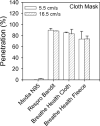Simple respiratory protection--evaluation of the filtration performance of cloth masks and common fabric materials against 20-1000 nm size particles
- PMID: 20584862
- PMCID: PMC7314261
- DOI: 10.1093/annhyg/meq044
Simple respiratory protection--evaluation of the filtration performance of cloth masks and common fabric materials against 20-1000 nm size particles
Abstract
A shortage of disposable filtering facepiece respirators can be expected during a pandemic respiratory infection such as influenza A. Some individuals may want to use common fabric materials for respiratory protection because of shortage or affordability reasons. To address the filtration performance of common fabric materials against nano-size particles including viruses, five major categories of fabric materials including sweatshirts, T-shirts, towels, scarves, and cloth masks were tested for polydisperse and monodisperse aerosols (20-1000 nm) at two different face velocities (5.5 and 16.5 cm s⁻¹) and compared with the penetration levels for N95 respirator filter media. The results showed that cloth masks and other fabric materials tested in the study had 40-90% instantaneous penetration levels against polydisperse NaCl aerosols employed in the National Institute for Occupational Safety and Health particulate respirator test protocol at 5.5 cm s⁻¹. Similarly, varying levels of penetrations (9-98%) were obtained for different size monodisperse NaCl aerosol particles in the 20-1000 nm range. The penetration levels of these fabric materials against both polydisperse and monodisperse aerosols were much higher than the penetrations for the control N95 respirator filter media. At 16.5 cm s⁻¹ face velocity, monodisperse aerosol penetrations slightly increased, while polydisperse aerosol penetrations showed no significant effect except one fabric mask with an increase. Results obtained in the study show that common fabric materials may provide marginal protection against nanoparticles including those in the size ranges of virus-containing particles in exhaled breath.
Figures






Similar articles
-
Nanoparticle penetration through filter media and leakage through face seal interface of N95 filtering facepiece respirators.Ann Occup Hyg. 2012 Jul;56(5):568-80. doi: 10.1093/annhyg/mer122. Epub 2012 Jan 31. Ann Occup Hyg. 2012. PMID: 22294504
-
A quantitative assessment of the total inward leakage of NaCl aerosol representing submicron-size bioaerosol through N95 filtering facepiece respirators and surgical masks.J Occup Environ Hyg. 2014;11(6):388-96. doi: 10.1080/15459624.2013.866715. J Occup Environ Hyg. 2014. PMID: 24275016 Free PMC article.
-
Evaluation of filter media for particle number, surface area and mass penetrations.Ann Occup Hyg. 2012 Jul;56(5):581-94. doi: 10.1093/annhyg/mes034. Ann Occup Hyg. 2012. PMID: 22752097
-
Effectiveness of face masks for the population.Ann Ig. 2021 Jul-Aug;33(4):347-359. doi: 10.7416/ai.2020.2390. Epub 2020 Dec 3. Ann Ig. 2021. PMID: 33258868 Review.
-
The Potential for Cloth Masks to Protect Health Care Clinicians From SARS-CoV-2: A Rapid Review.Ann Fam Med. 2021 Jan-Feb;19(1):55-62. doi: 10.1370/afm.2640. Ann Fam Med. 2021. PMID: 33431393 Free PMC article. Review.
Cited by
-
A laboratory-based study examining the properties of silk fabric to evaluate its potential as a protective barrier for personal protective equipment and as a functional material for face coverings during the COVID-19 pandemic.PLoS One. 2020 Sep 18;15(9):e0239531. doi: 10.1371/journal.pone.0239531. eCollection 2020. PLoS One. 2020. PMID: 32946526 Free PMC article.
-
Efficacy of cloth face mask in prevention of novel coronavirus infection transmission: A systematic review and meta-analysis.J Educ Health Promot. 2020 Jul 28;9:192. doi: 10.4103/jehp.jehp_533_20. eCollection 2020. J Educ Health Promot. 2020. PMID: 33015206 Free PMC article. Review.
-
Review of the Breathability and Filtration Efficiency of Common Household Materials for Face Masks.ACS Nano. 2021 Apr 27;15(4):5904-5924. doi: 10.1021/acsnano.0c10146. Epub 2021 Apr 6. ACS Nano. 2021. PMID: 33822580 Free PMC article. Review.
-
COVID-19 vulnerability: the potential impact of genetic susceptibility and airborne transmission.Hum Genomics. 2020 May 12;14(1):17. doi: 10.1186/s40246-020-00267-3. Hum Genomics. 2020. PMID: 32398162 Free PMC article. Review.
-
A review on the transmission of COVID-19 based on cough/sneeze/breath flows.Eur Phys J Plus. 2022;137(1):1. doi: 10.1140/epjp/s13360-021-02162-9. Epub 2021 Dec 10. Eur Phys J Plus. 2022. PMID: 34909366 Free PMC article. Review.
References
-
- Bailar JC, Brosseau LM, Cohen HJ, et al. Reusability of facemasks during an influenza pandemic. Facing the flu. Washington, DC: Institute of Medicine, National Academies Press; 2006.
-
- Blachere FM, Lindsley WG, Pearce TA, et al. Measurement of airborne influenza virus in a hospital emergency department. Clin Infect Dis. 2009;48:438–40. - PubMed
-
- CDC. Interim recommendations for the selection and use of protective clothing and respirators against biological agents. Atlanta, GA: Centers for Disease Control and Prevention; 2001.
-
- CDC. Interim domestic guidance on the use of respirators to prevent the transmission of SARS. Atlanta, GA: Centers for Disease Control and Prevention, Department of Health and Human Services, Public Health Service, Tuberculosis Control Division; 2003.
-
- CDC. Interim recommendations for the selection and use of protective clothing and respirators against biological agents. Atlanta, GA: Centers for Disease Control and Prevention, Public Health Service, Tuberculosis Control Division; 2004.
Publication types
MeSH terms
Substances
Grants and funding
LinkOut - more resources
Full Text Sources
Medical

